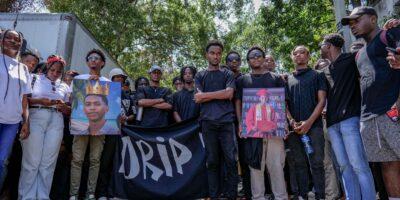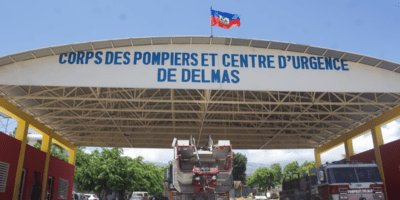A journey by car and motorcycle. But also one on foot, through the thicket of forests, where the paws of Dominican soldiers have to be greased, the main beneficiaries of border trafficking
$350 US dollars.
According to the smuggler, this is the minimum fare for a trip to the Dominican Republic.
A journey by car and motorcycle. But also one on foot, through the thicket of forests, where the paws of Dominican soldiers have to be greased; the main beneficiaries of trafficking across the border officially closed since September 2023.
For the history and geography teacher in Bas Delmas — stronghold of Jimmy “Barbecue” Chérizier ─ it is a life preserver on a sea rough with gang confrontations with police, kidnapping and the torching of businesses this March.
A dive “into the unknown” which, with a little luck, will bring him to Uncle Sam, explains the man, also a communications student at the State University of Haiti (UEH).
It’s a life preserver on a sea rough with gang confrontations with police, kidnapping and the torching of businesses this March.
Departure was set for dawn on March 20, 2024.
That day, the professor hastily left Barbecue’s stronghold – a former police officer who is now a terrifying gang leader – finds a way to Croix-des-Bouquets (another gang stronghold) to get to Belladère by bus.
The atmosphere on this part of the route “induces a cold sweat down your spine,” he says.
On the bus to Belladère, the passengers look like zombies on their way to purgatory. A heavy silence – disturbed only by the purr of the vehicle’s engine – falls on the passengers, consumed by fear.
“All phones are switched off,” says the man.
The smugglers know the terrain. Each time, the driver pays 10,000 gourdes as he crosses half a dozen toll booths, each manned by around 20 heavily armed gang members.
Read also: Haiti: Drivers leave the sector. They’ve had enough of the gangs.
Around one in the afternoon, the professor and his traveling companions arrive in Belladère, on the border.
There, three Haitian motorcyclists wait for them to continue their journey. They plan on bypassing a checkpoint at Elías Piña and to find a discreet path through a mountain.
The unknown bikers identify the Delmas native and his companions thanks to photos previously obtained via WhatsApp.
To be able to covertly cross the border, “the drivers bribed a Dominican guard post with around 1,000 pesos,” relates the professor.
Illicit payments are only just beginning.
Further on, in the Carisal area, three dangerous toll booths await travelers.
There, hooded individuals, armed with machetes, demand money before allowing access in a threatening tone, claiming that they themselves dug the road through the mountain.
The drivers agree and pay a few hundred gourdes.
To be able to covertly cross the border, “the drivers bribed a Dominican guard post with around 1,000 pesos.”
The rest of the way was uneventful until Elías Piña, around 5 p.m.
Arriving late in the city, the small group missed their bus to Santo Domingo.
As the sun slowly went out, the professor and his three companions decide to rent a small hotel room for the night, at a cost of $40 US dollars.
The establishment was made up of a dozen narrow rooms. So narrow that some rooms can only accommodate a single bed with unsanitary fittings.
Read also: Renting a house in the Dominican Republic, a real challenge for Haitians
The next day, they continued their journey on motorcycles through the town of Elías Piña, in order to avoid various paid checkpoints.
The bikers providing their transport, visibly very young, are hired in advance by the smuggler who organizes the trip.
In some places, the drivers ask passengers to take paths through the forest in order to bypass law enforcement officers.
“At times, they make us hide in dense forests and watch for the arrival of police or immigration agents on the roads,” explains the professor.
In some places, the drivers ask passengers to take paths through forests in order to bypass law enforcement officers.
The traveler claims to have been harassed by a biker due to the annoying movements of his feet and the latter’s fear of losing his balance on the motorcycle as he traveled at high speed. Additionally, one of his fellow travelers was slapped because he had not properly adjusted his feet on the motorcycle’s footrests.
It’s relatively mild treatment, compared to what usually happens, according to testimonies.
Migrants are murdered or brutally attacked.
Dominican drivers often beat passengers while insulting them with racist remarks: « ¡Maldito haitiano diablo, coño! » repeats the professor, who says he received “a lot of kicks and elbows.”
Then, they arrive at the town of San Juan.
On site, a convoy made up of two late-model cars, including a white Kia and a Jeep, awaited other Haitian migrants heading to the capital.
During the journey to Santo Domingo, one car carried 7 people and the other around 20. Some passengers were piled on top of each other, while others were placed inside the trunks of the cars.
Dominican drivers often beat passengers while insulting them with racist remarks: « ¡Maldito haitiano diablo, coño! »
On this route, the smuggler must pay around 1,000 pesos per person to avoid roadside checks. However, he cheats out of paying the full charges for everyone in both vehicles, by lying about their numbers.
The convoy manages to cross six checkpoints, with the exception of one last one, in a place commonly called “Ti Pilon,” reputed to be inflexible since the guards do not seem to allow themselves to be bribed, relates the professor.
There, they take the motorbikes again to avoid the checkpoint, then join the cars waiting to take them to Santo Domingo. Despite all of this, the young professor admits: “At least we are sure to stay alive.”
Hundreds of other Haitians, perhaps thousands, also choose to take this difficult journey.
The smugglers know the terrain. Each time, the driver pays 10,000 gourdes as he crosses half a dozen toll booths, each manned by around 20 heavily armed gang members.
The situation in Haiti remains explosive.
Since February 2024, a coalition of gangs named “ Live together » led by Barbecue regularly attacks public and private institutions, forcing the population to flee.
Last March, around 95,000 people left the capital to take refuge in the south of the country, according to the International Organization for Migration (IOM).
The Dominican Republic continues its mass deportations despite widespread paralysis.
In March 2024, according to IOM data, 12,598 people were forcibly returned to Haiti at the border in Ouanaminthe and Belladère.
Despite the unrest in Haiti, the Dominican Republic continues a policy considered hostile, xenophobic and racist towards its neighbor, according to human rights defenders.
Read also: Dominicans of Haitian descent face hard choices in DR Elections
The country closed its consulates and repatriated its staff. On March 5, 2024, the Dominican Civil Aviation Council stopped passenger and cargo flight operations to and from Haiti.
Inside the country, racial profiling is intensifying with arbitrary arrests and expulsions, as well as reported cases of rape.
A Haitian smuggler contacted by AyiboPost, asked for 42,500 gourdes to facilitate a trip to the Dominican Republic.
She stated that she was due to return to Haiti on Wednesday, March 27.
The passenger should also – according to her – have 2,500 gourdes to ensure their travel from Port-au-Prince to the border, with additional costs.
Travelers should minimize their luggage to avoid suspicion, according to the smuggler.
Edwin Paraison, coordinator of the Fondación Zile, confirms that such trafficking exists and stresses that it involves a chain of complicity from Haiti to the Dominican Republic. He also points out that authorities on both sides are taking advantage of the situation.
English translation by Sarah Jean.
Watch this AyiboPost report on the violence instigated in the Haitian capital by the “Viv Ansanm” gang coalition, led by former police officer Jimmy “Barbecue” Chérizier:
Keep in touch with AyiboPost via:
► Our channel Telegram : Click here
► Our Channel WhatsApp : Click here
► Our Community WhatsApp : Click here







Comments